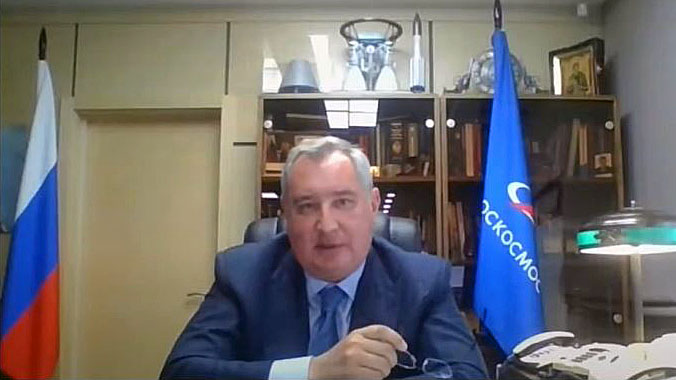SpaceX's Crew Dragon 'safe enough' to fly Russian cosmonauts, Roscosmos chief says
Russia previously voiced reservations about SpaceX experience with human spaceflight.

Russian cosmonauts will be allowed to fly to the International Space Station on SpaceX's Crew Dragon space capsule in the future as the technology has now proved to be sufficiently safe and reliable.
The director of Russia's space agency Roscosmos Dmitry Rogozin made such remarks during a press briefing at the International Astronautical Congress in Dubai on Monday (Oct. 25), SpaceNews reported.
Russia, which had had a monopoly on human spaceflight after the retirement of NASA's space shuttle in 2011, was previously vocal about their reluctance to fly on the private American spacecraft, citing SpaceX's lack of experience. That has now changed, Rogozin said, as SpaceX has already completed four successful crewed missions.
In May 2020, SpaceX brought the first two astronauts to the space station as part of a demo flight. The four-strong Crew-1 and Crew-2 followed in November 2020 and April 2021 respectively. In September, SpaceX successfully operated the first commercial orbital mission Inspiration 4, the first orbital flight of a civilian crew made up of non-professional astronauts.
"In our view, SpaceX has already acquired enough experience for us to be able to put our cosmonauts on Crew Dragon," Rogozin said through a translator, according to SpaceNews.
Related: Russia's space chief invites SpaceX's Elon Musk over for tea
The remarks are important for NASA, which is interested in exchanging seats between Crew Dragon and Russia's Soyuz crew vehicle, SpaceNews said.
Get the Space.com Newsletter
Breaking space news, the latest updates on rocket launches, skywatching events and more!
Rogozin said the two space agencies will discuss possible future arrangements during a meeting at the conference.
"I believe we will be in a position to discuss candidates who may be flying to the space station on board the Crew Dragon — Russian cosmonauts and American astronauts who will be flying to the space station on Russian spacecraft," Rogozin said according to SpaceNews.
NASA and SpaceX are currently in the final days of preparations to launch their Crew-3 mission, which is scheduled for Sunday (Oct. 31). The mission will launch a crew of four — NASA astronauts Raja Chari, Tom Marshburn, and Kayla Barron, as well as European Space Agency (ESA) astronaut Matthias Maurer — to the International Space Station to begin a six-month mission.
SpaceX's Crew-4 mission will follow in April 2022 with NASA astronauts Kjell Lindgren and Robert Hines and ESA's Samantha Cristoforetti aboard. A fourth crew member is yet to be announced.
SpaceNews reported that a Russian cosmonaut will not likely join a Dragon mission earlier than Crew-5. The earliest date for an American astronaut to fly on a Soyuz would be in the fall of 2022, since NASA has decided not to acquire a seat on the Soyuz MS-21 launching in March 2022, according to SpaceNews.
NASA has an interest in flying "mixed crews" of at least one NASA astronaut and one Roscosmos cosmonaut on each mission to ensure that both countries have a constant presence at the space station, SpaceNews reported. Such an arrangement would allow the space agencies to maintain their segments of the orbital outpost even if their own space taxis are grounded for a longer period of time.
"The important thing is that an agreement has to work for both of us," NASA Deputy Administrator Pam Melroy said in the same press briefing, according to SpaceNews. "There are considerations that we have and they have as well."
The last crewed SpaceX space mission, the four-day Inspiration4, experienced a minor problem with the capsule's toilet. A tube came disconnected in a urine waste tank, allowing liquid to leak into a fan system, Bill Gerstenmaier, SpaceX vice president for build and flight reliability, said late Monday in a NASA briefing.
The glitch didn't affect the flight, but contamination with a waste treatment chemical was discovered under the capsule's floor during post-landing checks. Inspections of the Crew-2 Crew Dragon spacecraft, which is currently docked to the station, also showed evidence of corrosion, but that corrosion does not grow over time based on lab tests in similar environmental conditions, SpaceNews reported.
Follow Tereza Pultarova on Twitter @TerezaPultarova. Follow us on Twitter @Spacedotcom and on Facebook.
Join our Space Forums to keep talking space on the latest missions, night sky and more! And if you have a news tip, correction or comment, let us know at: community@space.com.

Tereza is a London-based science and technology journalist, aspiring fiction writer and amateur gymnast. Originally from Prague, the Czech Republic, she spent the first seven years of her career working as a reporter, script-writer and presenter for various TV programmes of the Czech Public Service Television. She later took a career break to pursue further education and added a Master's in Science from the International Space University, France, to her Bachelor's in Journalism and Master's in Cultural Anthropology from Prague's Charles University. She worked as a reporter at the Engineering and Technology magazine, freelanced for a range of publications including Live Science, Space.com, Professional Engineering, Via Satellite and Space News and served as a maternity cover science editor at the European Space Agency.









